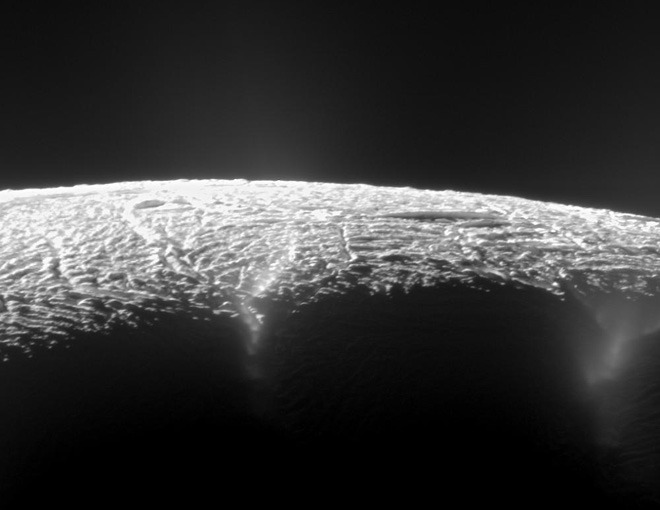
This view looks across the geyser basin of Saturn's moon Enceladus, along fractures spewing water vapor and ice particles into space. Cassini scientists have pinpointed the source locations of about 100 geysers and gained new insights into what powers them. Photo: NASA/JPL-Caltech/Space Science Institute.
WASHINGTON (PTI): Scientists using mission data from NASA's Cassini spacecraft have identified 101 distinct geysers erupting on Saturn's icy moon Enceladus.
Their analysis suggests it is possible for liquid water to reach from the moon's underground sea all the way to its surface.
Over a period of almost seven years, Cassini's cameras surveyed the south polar terrain of the small moon, a unique geological basin renowned for its four prominent "tiger stripe" fractures and the geysers of tiny icy particles and water vapour first sighted there nearly 10 years ago.
The result of the survey is a map of 101 geysers, each erupting from one of the tiger stripe fractures, and the discovery that individual geysers are coincident with small hot spots.
To determine the surface locations of the geysers researchers employed the same process of triangulation used historically to survey geological features on Earth, such as mountains.
When the researchers compared the geysers' locations with low-resolution maps of thermal emission, it became apparent the greatest geyser activity coincided with the greatest thermal radiation.
Comparisons between the geysers and tidal stresses revealed similar connections.
The researchers then compared the survey results with high-resolution data collected in 2010 by Cassini's heat-sensing instruments.
Individual geysers were found to coincide with small-scale hot spots, only a few dozen feet (or tens of metres) across, which were too small to be produced by frictional heating, but the right size to be the result of condensation of vapour on the near-surface walls of the fractures.
This immediately implicated the hot spots as the signature of the geysering process.
"Once we had these results in hand, we knew right away heat was not causing the geysers, but vice versa," said Carolyn Porco, leader of the Cassini imaging team from the Space Science Institute in Boulder, Colorado, and lead author of the first paper.
"It also told us the geysers are not a near-surface phenomenon, but have much deeper roots," Porco said.
The researchers concluded that the only plausible source of the material forming the geysers is the sea now known to exist beneath the ice shell.
They also found that narrow pathways through the ice shell can remain open from the sea all the way to the surface, if filled with liquid water.
The research is published in the Astronomical Journal.
 Previous Article
Previous Article Next Article
Next Article













The Indian Air Force, in its flight trials evaluation report submitted before the Defence Ministry l..
view articleAn insight into the Medium Multi-Role Combat Aircraft competition...
view articleSky enthusiasts can now spot the International Space Station (ISS) commanded by Indian-American astr..
view article